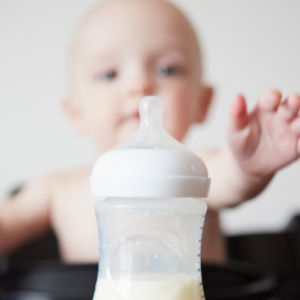Consumer Reports (CR) has made the news a few times over recent months blowing the whistle on toxins in certain mass-produced foods. Now, the watchdog is spotlighting warnings about toxins in commercially-prepared baby foods…
 The FDA wants to keep you and your new baby smiling! Recently announced new
The FDA wants to keep you and your new baby smiling! Recently announced new
initiatives to clamp down on contaminants in commercial formula products…
There’s good news and bad news. And even the bad news isn’t THAT bad – depending on how particular you are about contaminants in your baby’s formula…
Sounds apocalyptic…
…But there is, as usual, a ‘but’ to mitigate the situation. In fact, it comes down to whether you as a parent and consumer of commercial baby formulas consider any amount of contaminants in your baby’s formula ‘safe’.
According to the story on formulae in the latest issue of CR magazine: “[We] recently tested 41 types of powdered formula for a number of toxic chemicals, including arsenic, lead, BPA, acrylamide, and PFAS.
To be as fair – and as inclusive – as possible, “We looked at established formulas like Enfamil and Similac, newer startups like Bobbie, popular store brands, and imported brands.”
But let’s be clear: The ‘raw’ survey results show that 34 of the 41 formula samples tested showed detectable levels of contaminants. That’s more than 3 of every 4 samples tested.
Alarming results
“[A]bout half of the samples we tested contained potentially harmful levels of at least one conta-minant,” CR reveals.
However, there was a ‘balancing’ factor in the numbers. At the same time, the story states: “[I]t was also reassuring to see that the other half of the samples showed low or no levels of concerning che-micals – showing that there are many good options on the market.”
Here’s where the fog starts to roll in… When inevitable hair-splitters insist that, “there are [still] many good options on the market.” That doesn’t impress some moms who are justifiably concerned about ANY level of contaminants or ‘toxins’ in their infants’ food.
Case in point
The CR story spotlights new mom Kathryn Caves of Denver, CO. She had intended to breastfeed ex-clusively but ran into problems producing enough of her own milk.
Caves started supplementing with formula in the hospital while she worked to increase her breast milk supply, and continued to supplement with it throughout her baby’s infancy.
“So many people rely on formula — even people like me, who never intended to use it but came to rely on it,” Caves told CR. “It’s just what you have to do. You just kind of trust that it’s going to be safe.”
But now, now it’s up to her to decide what’s ‘safe’.
FDA responds
The Us Food and Drug Administration (FDA) responded the day after the CR survey report surfaced, announcing a broad, new initiative to increase its official ‘oversight’ on the formula industry. The FDA announcement specifically cited ‘increased testing’ for heavy metals and other contaminants.
My take
‘About 1 in 5 newborns in the U.S. start out eating formula exclusively’, according to the Centers for Disease Control and Prevention (CDC). ‘By 6 months of age, 3 out of 4 babies are consuming formula as part of their diet’. So contamination at any level is clearly an important issue.
It’s good to see the FDA making such a commitment to health of American children. Especially with the current slash-and-burn campaign by proxy-president Elon Musk and his DOGE organization heed-lessly cutting staff, funds and resources here, there and everywhere across the US federal government.
Let’s hope the new infant formula regulation also upgrades survive new Health and Human Resour-ces Czar Robert F. Kennedy Jr.’s at times extreme approach to food and drug regulation…
For now, though, the burden of deciding whether or not to trust baby formula sits directly on the shoulders of all the new moms across America…
~ Maggie J.

